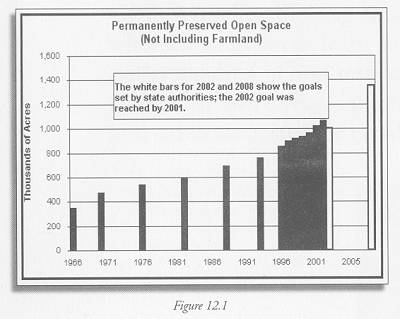Why do we care?
Open space helps keep the garden in the Garden State. Our rapid population growth has converted our farmlands and forests to suburban development, roads, and other paved surfaces. This is a cause for concern for many reasons. Open space protects the natural environment by providing habitat for wildlife. It absorbs rainfall, rather than sending it into the storm sewers and rivers; this minimizes the risk of floods and sedimentation of our waterways. It provides recreation on land and water. By protecting open space while it is still relatively inexpensive, we can ensure that there will be room for parks and natural areas when development does occur.
How are we doing?
Since 1966, New Jersey has almost tripled its permanently protected non-agricultural open space, which includes lands managed by federal, state and local governments, interstate agencies and nonprofit organizations. Some of these lands are available for public use, while others are privately held and have easements or other legal measures in place to ensure that they cannot be developed. By 2002, about 1,066,000 acres of open space were permanently preserved, exceeding the target for that year of one million acres of preserved land. Based upon the estimated 4,984,880 acres of land in New Jersey, this represents 22 percent of the state’s lands.
What is behind these figures?
Most of the acres preserved since 1970 were acquired through the Department of Environmental Protection’s Green Acres Program. In 1998, New Jerseyans voted to establish the Garden State Preservation Fund, which builds on the efforts of the Green Acres program by providing a stable source of capital to preserve one million acres of the state’s remaining open space.
Indicator 37 contrasts the amount of protected land in the state with the amount that has been developed. The juxtaposition of these two figures is less encouraging than this indicator alone. Without ongoing conservation programs, we could reach a point where all land in the state is developed except that which is explicitly protected.
What else would we like to know?
The data do not indicate the quality of nature in open spaces, whether the sites have been cleared of vegetation or contaminated by pollutants, what kinds of habitat they provide to wildlife, or whether they can be used by the public; they simply indicate the area. They also do not shed light on the debate over whether it is more important to preserve the maximum quantity of open space, or open space in areas where very little is left – even if the latter may be much more expensive. Knowing what we are protecting and where it is would give us a richer understanding of what we are accomplishing with our open space dollars. Knowing the roles of state government, local government, and private organizations in land protection would also contribute to our understanding of these trends.

Figure 12.1 Data on protected land through 2000 are from New Jersey Department of Environmental Protection. Land and Natural Resources. New Jersey’s Environment 2000. http://www.state.nj.us/dep/dsr/njenv2000/Land%20Resources.pdf
Current data may be obtained from Bob Stokes, Chief, Planning and Information Management Bureau, NJDEP Green Acres Program
Indicator Target:
By 2002, preserve at least 1,004,000 acres of open space. By 2008 preserve at least 1,354,000 acres of open space.
Current (2002) level:
1,066,000
Who set the target:
Governor Whitman’s 2nd Inaugural Address, January 1998.
